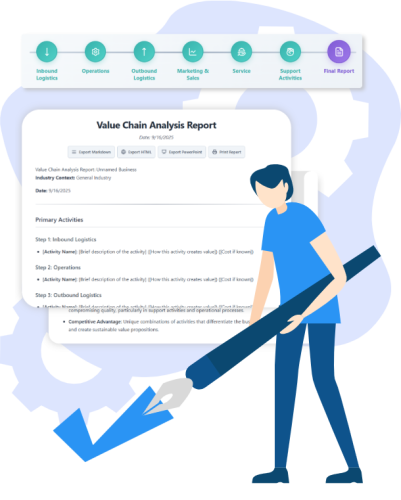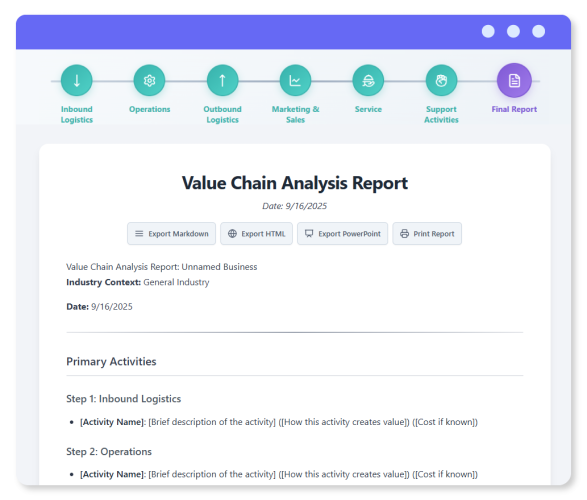How to Use the Value Chain Analysis Framework
Value Chain Analysis Tool is not just for filling out tables—it is a structured approach to understand and improve how your business creates value. By guiding you through a systematic analysis of your business activities, the framework helps you identify opportunities to increase competitive advantage and optimize performance.

What is a Value Chain?
A value chain is the full range of activities and processes that a business performs to create a product or service. Each step in the chain—from sourcing materials to customer service—adds value. By understanding these steps, you can pinpoint where you’re excelling and where there’s room for improvement. categories:
The framework divides these activities into two main categories:
Primary Activities: The core processes directly involved in creating and delivering a product or service, including inbound logistics, operations, outbound logistics, marketing and sales, and service.
Support Activities: The essential functions that enable the primary activities to run smoothly, such as procurement, technology development, human resources, and firm infrastructure.
How Does The Tool Help Solve Your Problem?
Think of our application as a digital workshop for your business strategy. Instead of a blank spreadsheet, you get a guided process. The tool’s step-by-step structure helps you systematically deconstruct your business, ensuring you do not overlook critical activities. The app’s value lies in its ability to:

Provide a Structured Framework
It guides you through the process, ensuring you analyze all key areas of your business.

Centralize Your Data
It serves as a single repository for all your analysis, making it easy to review and share.

Generate a Professional Report
Once you have entered your data, the app automatically compiles a comprehensive report, saving you the time and effort of manual formatting.
The Workflow: From Data Collection to Deliverable
The real power of this tool comes from the information you put in. The data is not something you can invent; it something you must discover by engaging with your organization.
Step 1. Gather the Data
Before you start filling out the tables, you will need to collect information from various stakeholders within your organization. Here’s how you can do that effectively:
Interviews and Discussions
Talk to department heads and key team members. For Inbound Logistics, speak with your supply chain manager. For Operations, interview your production or service delivery team. For Marketing & Sales, meet with your marketing and sales leads.
Document Analysis
Review internal documents like financial reports, process manuals, and performance dashboards to quantify costs and identify specific activities.
Cross-Functional Workshops
Host a workshop with representatives from different departments to collaboratively map out the value chain. This ensures accuracy and a shared understanding.
Step 2. Input Your Findings
As you collect data, use the app to document your findings. Go through each tab, one by one, and fill out the tables. For each activity, you will want to answer:
Activity: What is the specific action (e.g., “In-Store Service”)?
Description: What does this activity involve?
Value Added: How does this activity contribute to the final product’s value or customer experience? Be specific.
Cost: What are the associated costs? This is optional but highly recommended for a thorough analysis.
Step 3. Generate the Final Report
After completing the primary and support activities tabs, navigate to the Final Report tab. Click the “Update Report” button to compile all your entries into a clear, concise report.

The Deliverable: A Roadmap for Strategic Action
The final report is more than a summary of your entries; it is a strategic document. It will give you a complete, high-level overview of your business’s value chain. This report helps you:

Identify Strengths
Pinpoint key activities that are driving value and competitive

Find Opportunities
Discover areas where you can optimize costs, improve efficiency, or enhance customer value.

Align Teams
Use the report to align your team and stakeholders on strategic priorities, creating a shared vision for improvement.
Ready to Transform Your Business Strategy?
Gain clarity on your competitive advantages and start making smarter, data-driven decisions today.

